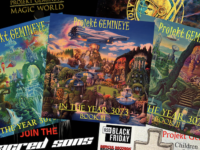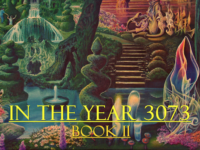Mark Anthony K joins Preston Frazier to discuss In the Year 3073: Book II, working with a series of guest stars including Billy Sherwood and Lee Pomeroy, and what lies ahead for Projekt Gemineye:
PRESTON FRAZIER: Projekt Gemineye’s In the Year 3073: Book I was brilliant, but didn’t have an upbeat ending. Does Book II complete the saga?
MARK ANTHONY K: Thank you very much for the kind words regarding Book I. The non-upbeat ending was purposefully done in order to set up the beginning of Book II. Once I started writing the story line and the lyrics for Book II, it became very clear that this story would need a Book III in order to tell the story properly. I honestly
think finishing with Book II would have left too many gaps in the story.
PRESTON FRAZIER: Did you write both albums as a complete project or did Book II come later?
MARK ANTHONY K: When I started Projekt Gemineye, my first album was called An Ordinary Day and the follow up was A Brand New Day. Those two albums were written and recorded at the same time, but just released at different times. So, I can see where this question may have come from. But no, each book has been written and recorded separately. I think that was for the best, as I was able to adjust and improve the story as I went. Of course, I had a sort of guideline or rough script, in which I followed but it wasn’t in stone.
PRESTON FRAZIER: Did your production approach differ from your earlier Projekt Gemineye projects?
MARK ANTHONY K: Yes, very much so. In fact, I’ve always tried to move forward production wise and make a more polished record, sonically speaking. Clarity, I think, is very important – being able to hear each instrument and hearing what they are playing in the songs. Sometimes bands go for a very large, heavy sound at the cost of clarity, but I believe you can make a strong impactful-sounding record and not sacrifice the overall sound. One of the things that I did this time around was to use my Hughes and Kettner tube amp, and record my guitar through the amp into a Marshall 4X12 cabinet and mic’d with a Shure 57 microphone.
The last couple of albums I’ve only used my Line 6 equipment and recorded direct into the DAW [Pro Tools’ Digital Audio Workstation], which gave the guitars a very different sound. On this record, the amp and Line 6 equipment were used and both combined to make the guitar sound you hear on the album. I feel it’s much more full sounding, and sits in the mix a lot better than past albums. Also, having guest bass players changed the production and sound, as each person had their own bass sound – and therefore I had to fit their sound into my overall sound. Luckily, each bass player’s sound fit well with my guitar and drum sounds.
PRESTON FRAZIER: Your Dark Monarchy partner, Joe Bailey, participates in the album. Why did you decide to incorporate him in a Projekt Gemineye project?
MARK ANTHONY K: Well, Joe was a part of Book I, which was recorded before we did the Dark Monarchy album. So, it only made sense to bring him back for Book II. The main reason I got Joe to sing on the album to begin with was to help tell the story. There are several characters in this story and if I sang everything, it would be hard to figure out what character was speaking during the songs. Having Joe sing made the story easier to follow.
PRESTON FRAZIER: This album also brings in some additional heavyweights. Why did you decide to ask Billy Sherwood, David Donley and Lee Pomeroy to contribute?
MARK ANTHONY K: To be honest, it all started with me asking Joe Bailey to play bass on a few of the songs. I love his bass playing style: He did all the bass on the Dark Monarchy album, so I was hoping he could do a few of the Projekt Gemineye songs. Once he agreed this idea came into my head: “What if i got a bunch of guest players on this album?” Since bass is a very important instrument in the prog genre, I thought it was a great idea. Luckily, I already knew David Donley, who has played with so many amazing musicians [including Glen Matlock, Woody Woodmansey and Ed Graham] – so that gave me a great start, as his playing on the song “The Back Streets of Paradise” is brilliant. Great feel and every note he plays is in the perfect place. And because of my connections in the music community, I was able to contact both Lee Pomeroy and Billy Sherwood and asked them to participate. When they both agreed, I knew I had a very strong group of guest musicians. Plus, I’ve been a long time fan of their work, whether its Lee’s work in the Steve Hackett band or Billy’s bass playing with Yes. I’m sure you will agree their playing on this album is fantastic.
PRESTON FRAZIER: If this is the conclusion of the In The Year 3073 project, does this mean the end to Projekt Gemineye?
MARK ANTHONY K: [Laughs] That’s a rather interesting question. Well, seeing that there still is another book coming out [in 2021] then, no it is not the end. And even when Book III comes out, I still feel I have a lot more to say as a musician and a songwriter. So, there will be more Projekt Gemineye albums to come.
PRESTON FRAZIER: Do you plan to do any promotional videos or live streams?
MARK ANTHONY K: Promotional videos are something I would like to do. I’m not sure if I will do one for this album, but you never know. As far as live streams go, I’m thinking about doing one so keep your eyes open for that. You will most likely find any information about that on my Facebook Group page.
PRESTON FRAZIER: What equipment did you use to record the album?
MARK ANTHONY K: For this album, I mainly used my Gibson Les Paul Studio and my Gibson SG J for all the rhythm-guitar playing. I find they each have a nice full sound that compliment each other. The Les Paul has a more smoother tone, while the SG has a little more brightness to it – mainly due to the ’60s model pickups. As I mentioned earlier, I used my Hughes and Kettner Tube amp and my Line 6 amp for recording the guitars. For the one song I did play bass on [“Get Away“], I used my Ibanez SG400 bass guitar which I played through an Ampeg Di BOX. The sound of the bass through that DI is incredible; it sounds so much like an amp. For keyboards, I used my Yamaha EX7 keyboard, along with a Roland GAIA and a Novation Bass Station keyboard. The EX7 has some amazing Hammond Organ sounds, as well as some incredible string sounds.
The GAIA is great for the lead-type sounds – very Minimoog sounding, and it also has some great Oberheim-type sounds as well. The Bass Station is great for low-end keyboard tones, sort of like the sounds from a Taurus Bass Pedal system. For vocals, I used a Warm Audio WA-47jr, which is very similar to a classic U-47 mic. I also used a Shure SM-7 mic for one song. I record everything through my ART 5-channel mixer, which I feel is sort of my secret weapon for my sounds, as the mic pre amps are very nice on it – and it also has a tube so it makes most sounds a little more warmer sounding. I much prefer going through the board than direct to the sound card.
- The Blackbyrds – ‘City Life’ (1975; 2025 reissue) - June 9, 2025
- Fernando Perdomo – ‘Waves 6’ (2025) - June 8, 2025
- Thelonious Monk – ‘Thelonious Himself’ (1957; 2025 vinyl reissue) - May 26, 2025




